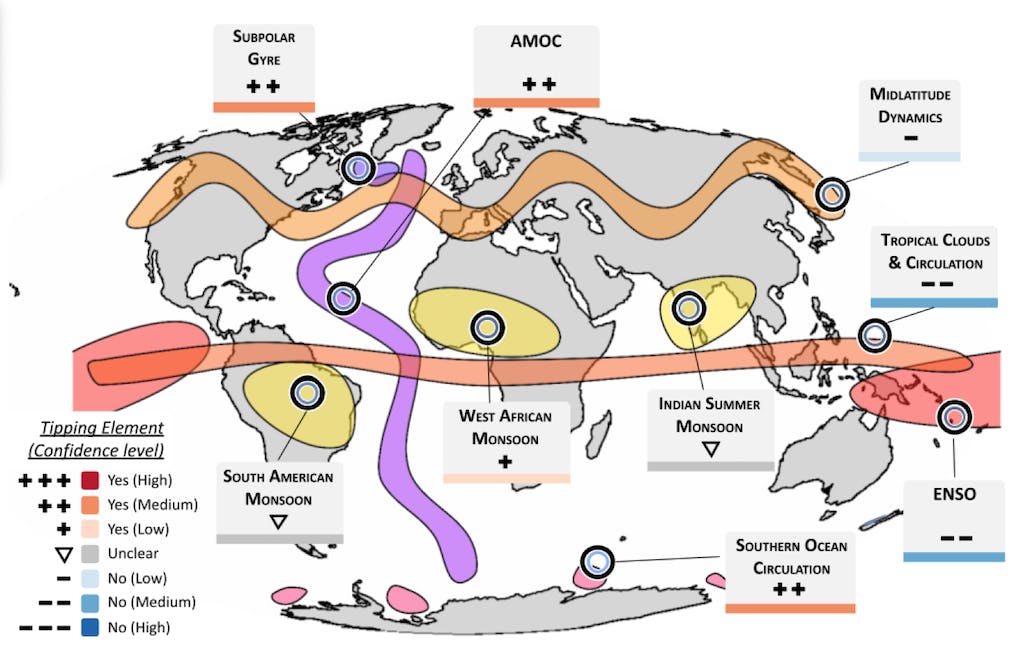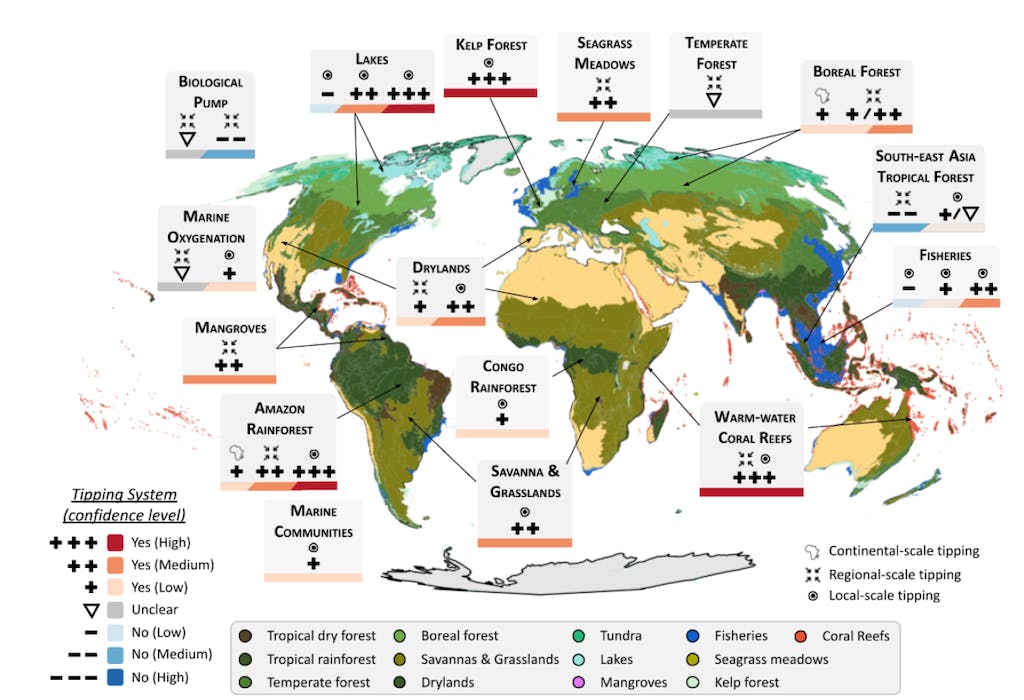These tipping points “pose some of the gravest threats faced by humanity”, according to the authors.
They identify more than 25 tipping points across the Earth system, ranging from ice-sheet collapse to rainforest dieback.
“Five major tipping points are already at risk of being crossed due to warming right now and three more are threatened in the 2030s as the world exceeds 1.5°C global warming,” the report finds.
Crossing Earth system tipping points would have “catastrophic” impacts on societies, with the potential to “escalate violent conflicts, mass displacement and financial instability”, the report also warns.
The authors say that promoting “positive social tipping points” in socio-behavioural, technological, economic and political systems is “the only realistic systemic risk governance option” to limit the risks.
Many positive tipping points have already been crossed – such as renewable energy becoming the cheapest form of electricity in some countries, and electric vehicles gaining the largest share of the market in others – the report finds.
An international team of more than 200 researchers have contributed to this report, which was initiated at a conference on tipping points in September 2022. (See Carbon Brief’s coverage of the event.) The report was funded by the Bezos Earth Fund.
“
The more visible sustainable choices are among the general population, the easier it becomes for politicians to make policy choices that might have seemed very difficult a few years ago.
Dr Tom Powell, research impact fellow, Exeter Global Systems Institute
The authors of the report support a proposal – currently under consideration – for the Intergovernmental Panel on Climate Change (IPCC) to prepare a special report on the topic of tipping points.
They also call for the risks and opportunities around tipping points to be included in the global stocktake of progress towards the goals of the Paris Agreement, as well as future revisions of Nationally Determined Contributions and national and sub-national policy measures.
In this Q&A, Carbon Brief unpacks the report’s findings on “negative” Earth system tipping points and “positive” social tipping points.
What are tipping points?
Scientists have warned for decades that many Earth systems are at risk of crossing “tipping points” – critical thresholds that, if exceeded, could push a system into an entirely new state.
Prof Tim Lenton is the chair of climate change and Earth system science at the University of Exeter and lead author of the new report on “global tipping points”. He describes a tipping point as when “a small change makes a big difference and changes the state or the fate of a system”.
The report uses the analogy of a ball in a valley to describe tipping points, as shown in the graphic below.
In the left-most panel (blue), the ball sits in the left-side valley. If the ball is given a small push, it rolls briefly up the side of the valley before returning to its starting position. This “resilience” – the system’s ability to withstand changes – shows that the system is stable, the report says.
However, the report warns that human activity – including climate change, ecosystem degradation and pollution – are making many Earth systems less stable. This is shown by the left-hand valley getting shallower in the middle panel (purple) and the lowering of the hill between it and the right-hand valley. Now it would be easier for the ball to move into the right-hand valley when pushed.
As a system comes close to a tipping point, it may be slower to return to its original state after a “perturbation” or disturbance, the report says. This would be shown by the ball returning more slowly to its original position after it is pushed.
Dr David McKay – an independent research consultant and visiting fellow at the University of Exeter’s Global Systems Institute – is a section lead on the new report. He describes this behaviour as a “wobble” and tells a press briefing that it can often be picked up using observational data. This is important, because it can provide an early warning signal that a tipping point is approaching.
A “tipping point” is crossed when the ball rolls past the point of no return into the right-side valley, leaving its original state and settling into a new stable state. This is shown in the right-hand panel (red). It is now very difficult for the ball to return to its original state in the left-hand valley.

A ball in a valley can be used as an analogy for tipping points. In the left-most panel (blue), the ball sits in the left-side valley in a stable state. Changes to the positions of the two wells in the middle panel (purple) show the system becoming unstable. A “tipping point” is crossed when the ball rolls into the right-side well where it settles into a new stable state. Source: Lenton et al (2023).
The report says that a tipping point occurs “when change in part of a system becomes self-perpetuating beyond a threshold, leading to substantial, widespread, frequently abrupt and often irreversible impact”.
Under this definition, it is also possible for tipping points to be reversible and “non-abrupt” – although this is not usually the case, the authors note.
What are the main Earth system tipping points?
In recent years, there has been plenty of academic discussion about which elements of the Earth system might exhibit tipping points.
The report synthesises hundreds of peer-reviewed articles to identify more than 25 parts of the Earth system that have tipping points across the cryosphere, biosphere, atmosphere and oceans. (Carbon Brief has previously unpacked nine of them in detail.)
Importantly, the authors also show which systems they do not believe to exhibit tipping behaviour.
Cryosphere
The report identifies multiple tipping points in the cryosphere, as shown on the map below.
The colours and markers indicate how confident the authors are that each system has a tipping point. A red bar and “+++” marker indicates that the authors are very confident that the system is a tipping point. A blue bar and “- – -” marker indicates that the authors are very confident that the system is not a tipping point. The four arrows and globe symbols indicate regional and global systems, respectively.

Cryosphere tipping points. The ++ and - - markers indicate how confident the authors are that the system has a tipping point. Source: Lenton et al (2023).
There are “multiple lines of evidence” to support the existence of “large-scale” tipping points from the melting of the Greenland and Antarctic ice sheets, the report says, explaining that if ice loss exceeds a threshold amount, self-amplifying feedbacks could cause the ice to disintegrate even faster, leading to large-scale ice-sheet “collapse”.
Conversely, the authors have “high confidence” that Arctic summer sea ice loss is not a tipping system, finding that in models and observations, summer sea ice loss tends to increase “gradually, but surely” in line with warming.
Meanwhile, the authors find evidence for “localised and regional” tipping points in glaciers and permafrost, but find that these systems do not exhibit “large-scale tipping dynamics”.
Oceans and atmosphere
There are four further tipping points in the oceans and atmosphere, including monsoons over west Africa, India and South America, clouds and El Niño southern oscillation (ENSO), according to the report. These are shown in the map below.

Ocean and atmosphere tipping points. The ++ and - - markers indicate how confident the authors are that the system has a tipping point. Source: Lenton et al (2023).
The Atlantic Meridional Overturning Circulation (AMOC) is a major system of ocean currents that plays an important role in regulating the global climate. The report explains that rising temperatures, combined with an influx of cold, fresh water from the melting of the Greenland ice sheet, could destabilise these ocean currents, potentially causing the entire system to “shut down”.
Similarly, the authors find evidence for tipping points in the overturning circulations in the Atlantic and the Southern oceans, as well as for the west African monsoon.
The authors also assess the literature on cloud-induced tipping points. Various different mechanisms linked to incoming solar radiation and outgoing infrared radiation have been suggested, but the authors conclude that “concern about cloud-driven tipping points is relatively low”.
Biosphere
The report finds the most tipping points in the biosphere, as shown in the map below. Different colours of shading indicate different biomes – for example, coral reefs in red and mangroves in pink.

Biosphere tipping points. The ++ and - - markers indicate how confident the authors are that the system has a tipping point. Source: Lenton et al (2023).
Systems in the biosphere have more “co-drivers” that can reduce their resilience – such as climate change, habitat loss and pollution – making tipping points easier to reach, the report finds.
For example, it notes that the Amazon provides much of its own rainfall by cycling water between the atmosphere and vegetation. Deforestation and climate change can disrupt this mechanism, pushing the system over a tipping point where it turns from forest into savannah. This process is called forest “dieback”.
Among tropical forests, there is most evidence of a tipping point for the Amazon, the report finds. Other tropical forests such as the Congo have evidence for local tipping points, but are less likely to cross them, the report finds.
The authors also find that mangroves and sea grasses – which are “historically among the most human-threatened ecosystems in the world” – are at risk tipping regionally. They highlight regional examples of “mangrove die-off”, which typically occur when the mangroves are “physiologically stressed”.
The report also looks at marine food webs and fisheries, finding that “marine community shifts take place when abrupt changes cascade through several species or functional groups of an ecosystem”.
When could key thresholds be crossed?
Assessing when key climate tipping points may be crossed has been a key area of research for many years. One way to identify imminent tipping points is by looking for the “wobble” or “loss of resistance” in a system.
For example, the report cites research that finds three-quarters of the Amazon rainforest has lost “resilience” since 2003, making it slower to recover from droughts and heatwaves. This indicates that the forest could be approaching a tipping point, the authors say.
Parts of the Greenland ice sheet and AMOC are also exhibiting a loss of resilience, the report finds. It adds that given present-day warming of 1.2°C, tipping of warm-water coral reefs is likely:
“Coral reefs are already experiencing tipping points, as more frequent warming-driven bleaching events, along with pollution, extreme weather events and diseases, tip them to degraded algae-dominated states.”
As the planet continues to warm, the likelihood of crossing key thresholds increases. The report also draws on research recently published by McKay, which assesses how many tipping points could be triggered at different levels of global warming.
The upper half of the plot below shows the likelihood of triggering 15 tipping elements at different temperature levels. Yellow indicates a low likelihood and red indicates a high likelihood, while the dotted line indicates a central estimate.
The grey line underneath shows observed warming to the present day and projections out to 2100 from 1.5°C (green) to more than 4°C (red). The grey shading in the upper chart indicates expected warming given current climate policies.

Plot showing the likelihood of crossing 15 tipping points at different warming levels (left). Expected warming (top right) and number of tipping points crossed (bottom right) at different warming trajectories. Source: McKay et al (2022).
The report says that five different tipping points are already “at risk of being crossed due to warming right now”. These are Greenland and West Antarctic ice sheet collapse, warm-water coral reef die-off, widespread localised abrupt thaw in permafrost and overturning circulation collapse in the North Atlantic subpolar gyre.
The North Atlantic subpolar gyre is a counter-clockwise ocean current to the south of Greenland, which drives the oceanic currents and redistributes heat and freshwater in the high latitude North Atlantic. The gyre is a component of AMOC, and is considered as a major tipping element of the climate system.
The report adds that three more tipping points are at risk of being crossed in the 2030s as the world exceeds 1.5°C above pre-industrial temperatures.
However, the report warns that key thresholds could be crossed “at lower levels of global warming than previously thought”, adding:
“Our best models likely underestimate tipping point risks. The world is largely flying blind into this vast threat.”
This underestimation is largely due to “patchy and fragmented” knowledge, the authors say. For example, they note that “typical modelling approaches struggle to accurately represent ice sheet dynamics”.
The authors of the report support a proposal for the IPCC to prepare a special report on the topic of tipping points. The proposal was put forward by Switzerland in May 2022 and is currently under consideration.
What are the impacts of crossing tipping points?
The impacts of crossing Earth system tipping points “could be catastrophic”, the report warns.
Melting of the Greenland and Antarctic ice sheets would endanger coastal communities, and could lead to the complete loss of many small island nations, the report finds. Antarctic ice sheet instability alone could lead to a potential sea level rise of two metres by 2100, exposing 480 million people to annual coastal flooding events, it says.
Amazon dieback would be a “catastrophe for biodiversity”, the report finds. Reduced river flow would lead to transport difficulties in the region, and some six million people would face “extreme heat stress risk”. Overall, the report estimates that a complete Amazon dieback would cause damages of between $1tn and $3.5tn.
Thawing permafrost causes the ground to become unstable or “slump”, and the report warns that 70% of current infrastructure in permafrost regions is in areas with “high potential for thaw by 2050”.
It adds that crossing a tipping point in the AMOC would lead to global changes in rainfall patterns, with implications for water security and crop production around the world. The warm water that the AMOC carries northwards releases heat into the atmosphere, which means it plays a crucial role in keeping Western Europe warm.
However, the Earth system tipping points do not act in isolation. The authors find that crossing some tipping points, such as the dieback of rainforests or thawing of permafrost, releases more CO2 into the atmosphere, causing further warming.
Furthermore, many Earth systems are interlinked, meaning that crossing one tipping point can increase the likelihood of crossing others. The authors describe this as a “domino effect” or “tipping cascade”.
The map below shows these interactions. Red arrows indicate that crossing one tipping point causes another system to become more unstable, making it more likely to tip. Blue arrows indicate the opposite. Grey arrows indicate unclear effects.
Systems that may not tip on their own – but are still important due to their interactions with other systems – are shown with a blue outer circle. Tipping systems that exert a notable feedback on global average temperature when they tip are denoted by a red inner ring.

Interactions between different climate tipping elements. Source: Lenton et al (2023).
The report finds that the majority of interactions between climate tipping systems are destabilising – indicating that crossing one tipping point will generally lead to further tipping points being crossed.
For example, disintegration of the Greenland ice sheet would result in large volumes of cool freshwater flowing into the ocean, which could push the AMOC beyond a tipping point. This, in turn, could lead to an intensification of ENSO, which could go on to influence weather patterns over the Amazon, causing rainforest dieback, the report explains.
Crossing key tipping points “could have catastrophic impacts on human societies”, including an increase in violence and conflict, large-scale displacement and financial destabilisation, the authors warn.
The report says that Earth system destabilisation could lead to “social cohesion breaking down”, driving an increase in “mental disorders”, as well as “greater radicalisation of various groups and polarisation, making it harder to find collective solutions”. The report adds:
“These impacts could escalate to threaten the breakdown of economic, social and political systems, triggering destructive tipping points in societies experiencing stresses beyond their ability to cope.”
The authors add that each time a tipping point is crossed, humanity will be forced to divert more attention and resources into disaster response, “eroding away some of our agency
to tackle the underlying drivers”. This in turn would make it more likely for more tipping points to be crossed in the future, creating a “vicious cycle”, they say.
Can ‘positive tipping points’ mitigate the risks?
“The existence of tipping points means that ‘business as usual’ is now over,” the report warns. It adds:
“Rapid changes to nature and society are occurring, and more are coming. If we don’t revise our governance approach, these changes could overwhelm societies as the natural world rapidly comes apart.”
However, the authors add that “currently, there is no adequate global governance at the scale of the threats posed by negative tipping points”.
The authors argue that “positive social tipping points” – feedbacks in socio-behavioural, technological, economic and political systems that trigger a positive change – could be “the only realistic systemic risk governance option” to limit the risks.
Lenton told the press briefing that humanity has “left it basically too late for incremental action on the climate crisis”, adding that positive tipping points are key to limiting dangerous levels of warming.
Many positive social tipping points are being reached or have already been crossed, the authors say.
For example, they say that renewable energy has reached a tipping point of cost parity with fossil-fuelled power generation. They add that electric vehicles “show evidence of passing or approaching tipping points in major markets including China and Europe”.
Dr Tom Powell – a research impact fellow at Exeter’s Global Systems Institute and section lead on the report – told the press briefing that “the more of something we build, the cheaper it gets to build”.
He called this a “powerful reinforcing feedback”, adding that it is responsible for some of those cost reductions and renewable energies and electric vehicles.
In a similar way to negative Earth system tipping points, one positive social tipping point can trigger another, leading to a domino or cascade that generates “widespread societal change”, the authors say. Lenton outlined a positive tipping cascade in electric vehicle manufacture:
“As electric vehicles pass the positive tipping point of market dominance, this produces lots of cheap batteries, and those low cost batteries are crucial to provide essential storage capacity to reinforce a different positive tipping point towards renewable energy for our power supply.
“And that can in turn trigger positive tipping points in producing green ammonia and green hydrogen fuels for fertiliser, shipping and so on.”
Powell adds that “social contagion is a really powerful force”, noting that “the more people around you who are adopting sustainable choices, the more likely you are to do so yourself”. He adds:
“The more visible sustainable choices are among the general population, the easier it becomes for politicians to make policy choices that might have seemed very difficult a few years ago.”
However, positive social tipping points “don’t just happen by magic”, Lenton told the press briefing. Instead, he said they need “coordinated action”.
The report’s authors call for Earth system tipping point risks, corresponding action and positive tipping point opportunities to be included in the global stocktake under the Paris Agreement, as well as future revisions of Nationally Determined Contributions (NDCs) and national and sub-national policy measures.
The most recent iteration of the global stocktake text mentions climate tipping points twice. In one, it invites the scientific community to:
“Generate information relevant for NDCs and aligning them with 1.5°C, cross-cutting considerations such as tipping points, guidance on risks and impacts, vulnerability, cryosphere and closing observation gaps.”
Dr Manjana Milkoreit – a postdoctoral fellow at the University of Oslo and section lead on the report – adds that decisions and actions taken in the coming decades will commit us to “really long-term changes”, adding that the issue of tipping points is important for our notions of intergenerational justice.
This story was published with permission from Carbon Brief.

















